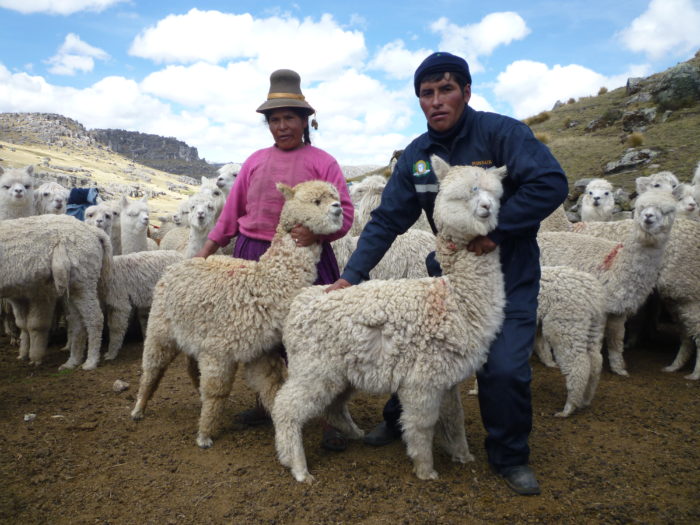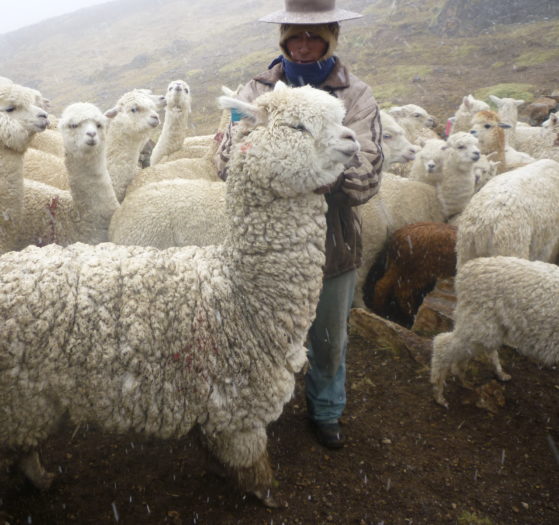Part 1

Josefina Martinez and Pedro Pocco
The young veterinarian was flanked by three Quechua alpaca breeders, each with their felted cowboy hats firmly in place and nary a smile on their stoic, weather creased faces. They were from an important alpaca-growing region in district of Corani, near Macusani.
The small conference table in Quechua Benefit’s Arequipa office was rounded out by Alejandro Tejada, Peru Country Director for Quechua Benefit, and myself. Veterinarian Armando Fernandez was enthusiastically explaining that they had come to formally ask for the NGO’s assistance in establishing an Estimated Progeny Difference (EPD) program in their region. The three alpaca breeders looked on, impossible to read.

Tomas Mamani, Quelcaya
I turned to the men and asked how the breeders would decide on which alpacas would be chosen to establish the nucleus herd, which is necessary to activate an EPD project. I told them I was concerned that the 150 families that wanted to participate might hold back their best machos and thereby doom the project. The trio finally smiled.
“I can see that you understand alpaca breeders,” said one of the men. The meeting warmed up a bit and we said we would consider how we might provide assistance.
The request from the contingent of breeders held a lot of promise and an opportunity to do good for Quechua Benefit’s primary constituents, the families of alpaca breeders.
Dr. Armando Fernandez dreamed of using science to improve alpacas in Peru when he approached me to discuss the possibility of establishing an EPD program and fleece improvement project. He was familiar with the program in the United States and knew that I worked with Quechua Benefit in the alpaca growing regions of Peru.
Armando was born and raised in Puno and studied at the National University of Altiplano, graduating as a veterinarian specializing in alpaca research. He has participated in local agricultural fairs as the chief judge of alpacas.

Lizeth (host), Frame (breeder), Martin (president of the fair), Dr. Armando Fernandez (Head Judge), Joseph (breeder)
After several emails, we agreed to meet in Arequipa. Together, we decided to create an EDP program.
The idea seemed to be losing steam until a new email popped up on my computer screen. Armando took Quechua Benefit’s promise of technical assistance alongside a program proposal to a co-op of breeders and the Mayor of Corani, Edmund Caceress.
The co-op includes 150 families (500 individual members) and is situated in the communities of Quelcaya, Chacaconiza and Chimboya. Together they own 42,728 alpacas. The nucleus herd will be pastured on approximately 300 acres.
The ability to scientifically establish breeding values (or EPD’s) for selection of alpacas in Peru will greatly accelerate the improvement of their breeding stock.
The potential for positive financial impact on the families of Corani is particularly significant. Today the average family in the group makes $457.00 per year from fiber (50%), meat (40%) and breeding stock sales (10%). Each family makes about 65% of their total income from alpacas. Armando expects each family’s income to increase by 30%, primarily from the value created by selling classified fiber and additional breeding stock.
Together, the team of Alejandro and Armando successfully applied for and received a financial grant for the project from a Canadian company, Bear Creek Mining, who operates in the area.
Then a unique turn in the road led the QB Ambassador team down under.
Part 2 will reveal how technology can be united with a remote community practicing a 5,000 year tradition of alpaca breeding.
